Preparation and Road Performance Study of Rubber–Diatomite Composite-Modified Asphalt Mixture
Abstract
:1. Introduction
2. Materials and Methods
2.1. Raw Materials
2.2. Mixture Aggregates
2.3. Mineral Fillers
2.4. Experimental Design
2.5. Preparation of Composite-Modified Asphalt
2.6. Design of Asphalt Mixture Grading
2.7. Test Process and Methods
3. Asphalt Test Results and Discussion
3.1. Determination of the Optimal Dosage of Modifier for Composite-Modified Asphalt
3.1.1. Determination of Modifier Asphalt Dosage
3.1.2. Determination of Optimal Composition for Composite-Modified Asphalt
3.2. Microscopic Mechanism Analysis
3.2.1. Fourier Transform Infrared Spectroscopy (FTIR) Experimental Analysis
3.2.2. SEM Analysis of Rubber–Diatomite
4. Performance Evaluation of Modified Asphalt Mixtures
4.1. The Marshall Test of Asphalt Mixtures
4.2. The High-Temperature Stability of Asphalt Mixture
4.2.1. The Wheel Tracking Test of Asphalt Mixture
4.2.2. The Wheel Tracking Test of Asphalt Mixture Aging
4.3. The Long-Term Water Stability Performance Test
4.3.1. The Cyclic Freeze–Thaw Splitting Test
4.3.2. The Cyclic Freeze–Thaw Drying Aging Splitting Test
5. Conclusions and Further Research
5.1. Conclusions
5.2. Further Research
Author Contributions
Funding
Institutional Review Board Statement
Informed Consent Statement
Data Availability Statement
Conflicts of Interest
References
- Zhang, Z.Y.; Wang, Z.H.; Zhang, L.; Wang, S.; Zeng, W. Construction and assessment technology of green road in China. J. Chang. Univ. (Nat. Sci. Ed.) 2018, 38, 76–86. [Google Scholar]
- Wang, C.H.; Li, Y.D.; Wen, P.H.; Zeng, W.; Wang, X.Q. A comprehensive review on mechanical properties of green controlled low strength materials. Constr. Build. Mater. 2022, 363, 129611. [Google Scholar] [CrossRef]
- Wang, C.H.; Wang, M.H.; Chen, Q.; Zhang, L. Basic performance and asphalt smoke absorption effect of environment-friendly asphalt to improve pavement construction environment. J. Clean. Prod. 2022, 333, 130142. [Google Scholar] [CrossRef]
- Jiang, W.; Huang, Y.; Sha, A. A review of eco-friendly functional road materials. Constr. Build. Mater. 2018, 191, 1082–1092. [Google Scholar] [CrossRef]
- Lv, Y.; Wu, S.; Li, N.; Cui, P.; Wang, H.; Amirkhanian, S.; Zhao, Z. Performance and VOCs emission inhibition of environmentally friendly rubber modified asphalt with UiO-66 MOFs. J. Clean. Prod. 2023, 385, 135633. [Google Scholar] [CrossRef]
- Lyu, L.; Pei, J.Z.; Hu, D.L.; Sun, G.Q.; Fini, E.H. Bio-modified rubberized asphalt binder: A clean, sustainable approach to recycle rubber into construction. J. Clean. Prod. 2022, 345, 131151. [Google Scholar] [CrossRef]
- Presti, D.L. Recycled tyre rubber modified bitumens for road asphalt mixtures: A literature review. Constr. Build. Mater. 2013, 49, 863–881. [Google Scholar] [CrossRef]
- Wang, X.P.; Hong, L.; Wu, H.J.; Liu, H.; Jia, D. Grafting waste rubber powder and its application in asphalt. Constr. Build. Mater. 2021, 271, 121881. [Google Scholar] [CrossRef]
- Zhao, Z.G.; Wu, S.P.; Jun, X.; Yang, C.; Yang, X.K.; Chen, S.C.; Liu, Q.T. Recycle of waste tire rubber powder in a novel asphalt rubber pellets for asphalt performance enhancement. Constr. Build. Mater. 2023, 399, 132572. [Google Scholar] [CrossRef]
- Duan, S.C.; Muhammad, Y.; Li, J.; Maria, S.; Meng, F.; Wei, Y.H.; Su, Z.B.; Yang, H.Q. Enhancing effect of microalgae biodiesel incorporation on the performance of crumb Rubber/SBS modified asphalt. J. Clean. Prod. 2019, 237, 117725. [Google Scholar] [CrossRef]
- Liu, L.; Liu, Z.H.; Li, S. The Preparation Technology and Performance Study of SBS and Rubber Powder Composite Modified Asphalt. Appl. Mech. Mater. 2013, 361–363, 1617–1620. [Google Scholar] [CrossRef]
- Zhuang, C.Y.; Guo, H.; Li, F.X.; Hao, Y.; Chen, K.; Li, G.; Ye, Y.L. Study on Adhesion Performance and Aging Strength Degradation Mechanism of SBS Modified Asphalt with Different Anti-Aging Additive. Materials 2023, 16, 4881. [Google Scholar] [CrossRef]
- Li, N.; Wang, J.; Si, W.; Hu, D.X. Quantitative analysis of adhesion characteristics between crumb rubber modified asphalt and aggregate using surface free energy theory. Materials 2022, 15, 5735. [Google Scholar] [CrossRef]
- de Albornoz, F.J.S.-C.; Moreno-Navarro, F.; Rubio-Gámez, M.D.C. Analysis of the Real Performance of Crumb-Rubber-Modified Asphalt Mixtures. Materials 2022, 15, 8366. [Google Scholar] [CrossRef]
- Qian, C.D.; Fan, W.Y.; Yang, G.M.; Han, L.; Xing, B.D.; Lv, X.B. Influence of crumb rubber particle size and SBS structure on properties of CR/SBS composite modified asphalt. Constr. Build. Mater. 2020, 235, 117517. [Google Scholar] [CrossRef]
- Li, Z.X.; Guo, T.T.; Chen, Y.Z.; Dong, L.C.; Chen, Q.; Hao, M.H.; Zhao, X.; Liu, J.Y. Study on Rheological Properties of Graphene Oxide/Rubber Crowd Composite-Modified Asphalt. Materials 2022, 15, 6185. [Google Scholar] [CrossRef]
- Zhang, F.; Hu, C. The research for crumb rubber/waste plastic compound modified asphalt. J. Therm. Anal. Calorim. 2015, 124, 729–741. [Google Scholar] [CrossRef]
- Sienkiewicz, M.; Borzędowska-Labuda, K.; Zalewski, S.; Janik, H. The effect of tyre rubber grinding method on the rubber-asphalt binderproperties. Constr. Build. Mater. 2017, 154, 144–154. [Google Scholar] [CrossRef]
- Li, F.; Zhang, X.; Wang, L.; Zhai, R. The preparation process, service performances and interaction mechanisms of crumb rubber modified asphalt (CRMA) by wet process: A comprehensive review. Constr. Build. Mater. 2022, 354, 129168. [Google Scholar] [CrossRef]
- Azahar, N.F.B.M.; Hassan, N.A.; Jaya, R.P.; Kadir, M.A.B.A.; Yunus, N.Z.B.M.; Mahmud, M.Z.H. An overview on natural rubber application for asphalt modification. Int. J. Agric. For. Plant 2016, 2, 212–218. [Google Scholar]
- Li, H.; Cui, C.; Temitope, A.A.; Feng, Z.; Zhao, G.; Guo, P. Effect of SBS and crumb rubber on asphalt modification: A review of the properties and practical application. J. Traffic Transp. Eng. (Engl. Ed.) 2022, 9, 836–863. [Google Scholar] [CrossRef]
- Dos Santos, A.A.M.; Cordeiro, G.C. Investigation of particle characteristics and enhancing the pozzolanic activity of diatomite by grinding. Mater. Chem. Phys. 2021, 270, 124799. [Google Scholar] [CrossRef]
- Du, T.; Song, P.; Liu, L.P. Experimental Study on Activated Diatomite Modified Asphalt Pavement in Deep Loess Area. Processes 2022, 10, 1227. [Google Scholar] [CrossRef]
- Huang, W.T.; Wang, D.Y.; He, P.Y.; Long, X.; Tong, B.; Tian, J.; Yu, P. Rheological Characteristics Evaluation of Bitumen Composites Containing Rock Asphalt and Diatomite. Appl. Sci. 2019, 9, 1023. [Google Scholar] [CrossRef]
- Long, Y. Research on Key Technology of Diatom Composite Modified Asphalt Mixture. Master’s Thesis, Chang’an University, Xi’an, China, 2018. [Google Scholar]
- Luo, S.J.; Chen, N.C.; Tan, B.; Wu, C.; Chen, Q.L. Mechanism and performance of diatomite modified asphalt. Acta Mater. Compos. Sin. 2016, 34, 2047–2052. [Google Scholar]
- Chen, Q. Study on the Grading of Silicone Modified Asphalt Mixture in Southern Damp and Hot Regions. J. China Foreign Highw. 2017, 224–229. [Google Scholar]
- Liu, H.; Zhang, M.; Jiao, Y. Preparation Parameter Analysis and Optimization of Sustainable Asphalt Binder Modi-fied by Waste Rubber and Diatomite. Adv. Mater. Sci. Eng. 2018, 2018, 1–14. [Google Scholar]
- Yang, C.; Xie, J.; Zhou, X.; Liu, Q.; Pang, L. Performance Evaluation and Improving Mechanisms of Diato-mite-Modified Asphalt Mixture. Materials 2018, 11, 686. [Google Scholar] [CrossRef]
- Tan, Y.; Zhang, L.; Zhang, X. Investigation of low-temperature properties of diatomite-modified asphalt mixtures. Constr. Build. Mater. 2012, 36, 787–795. [Google Scholar]
- Liang, C.; Zhang, H.; Gu, Z. Study on Mechanical and Viscoelastic Properties of Asphalt Mixture Modified by Diatomite and Crumb Rubber Particles. Appl. Sci. 2020, 10, 8748. [Google Scholar] [CrossRef]
- Cheng, Y.; Li, L.; Zhou, P.; Zhang, Y.; Liu, H. Multi-Objective Optimization Design and Test of Compound Diatomite and Basalt Fiber Asphalt Mixture. Materials 2019, 12, 1461. [Google Scholar] [CrossRef]
- Arturs, R.; Viktors, H.; Verners, S. Economic and environmental analysis of crumb rubber modified asphalt. Constr. Build. Mater. 2022, 335, 127468. [Google Scholar]
- Al-Sabaeei, A.M.; Safaeldeen, G.I.; Napiah, M. Utilization of response surface methodology for predicting and optimizing the physical properties of rubberized asphalt modified with nanosilica and waste denim fiber. Clean. Eng. Technol. 2023, 15, 100666. [Google Scholar] [CrossRef]
- Heydari, S.; Hajimohammadi, A.; Javadi, N.H.S. Modified asphalt by coffee cup Fibres: An optimum mix design using response surface method. Constr. Build. Mater. 2023, 401, 133005. [Google Scholar] [CrossRef]
- JTG E20-2011; Ministry of Transport (2011) Standard Test Methods of Asphalt and Bituminous Mixtures for Highway Engineering. People’s Communications Publishing House: Beijing, China, 2011.
- JTG E42-2005; Test Methods of Aggregate for Highway Engineering. Ministry of Communications: Beijing, China, 2005.
- Pei, M. Research on the Optimized Preparation Process and Anti-Aging Property of Diatomite-Crumb Rubber Compound Modified Asphalt. Master’s Thesis, Jinlin University, Changchun, China, 2016. [Google Scholar]
- JTG F40-2004; Technical Specification for Construction of Highway Asphalt Pavements. Chinese Industry Standard: Beijing, China, 2004.
- DB45/T 1098-2014; Technical Specification for Construction of Rubber Asphalt Pavement. Guangxi Local Standard: Guangxi, China, 2014.
- Liang, M.; Ren, S.; Fan, W.; Wang, H.; Cui, W.; Zhao, P. Characterization of fume composition and rheological properties of asphalt with crumb rubber activated by microwave and TOR. Constr. Build. Mater. 2017, 154, 310–322. [Google Scholar] [CrossRef]
- Rui, G.; Teng, N.; Fei, Z. Analysis of factors that influence anti-rutting performance of asphalt pavement. Constr. Build. Mater. 2020, 254, 119237. [Google Scholar]
- Ali, H.A.; Haddadi, F.; Mohammadafzali, M.; Sholar, G.; Moseley, H. Effect of Rejuvenated Binder on the Pavement Rutting Performance at Different Aging Levels. Adv. Mater. Sci. Eng. 2020, 2020, 9693821. [Google Scholar] [CrossRef]
- Huang, X.; Tang, C.; Tang, X.; Luo, B.; Liu, X. Experimental study on treatment technology of acidic granite asphalt mixture. Highway 2023, 81–86. [Google Scholar]
- Ma, C. Research on the Road Performance and Frost Resistance of Diatomaceous Earth Rubber Particle Composite Modified Asphalt Mixture in Seasonal Frozen Zone. Master’s Thesis, Jilin University, Changchun, China, 2016. [Google Scholar]

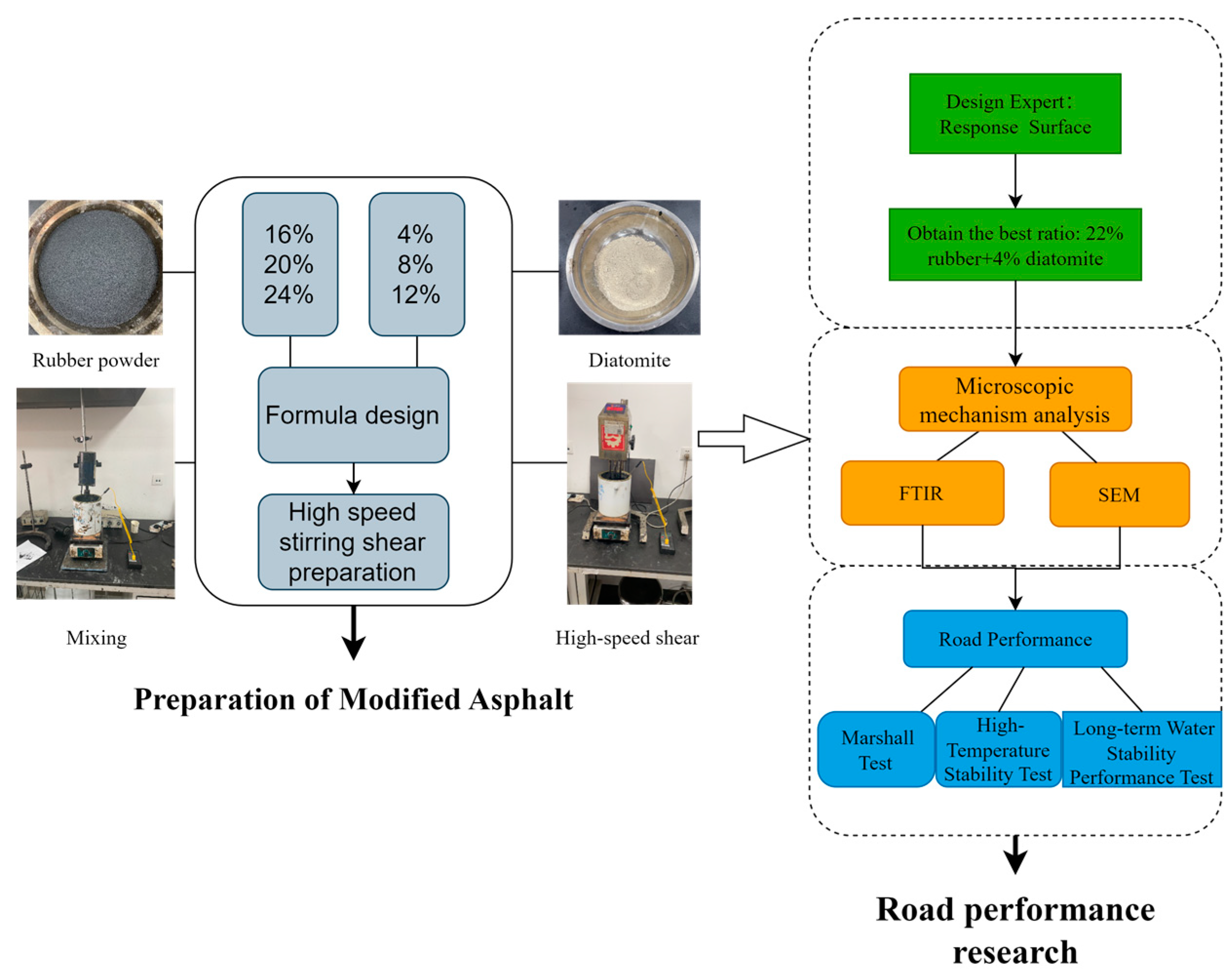
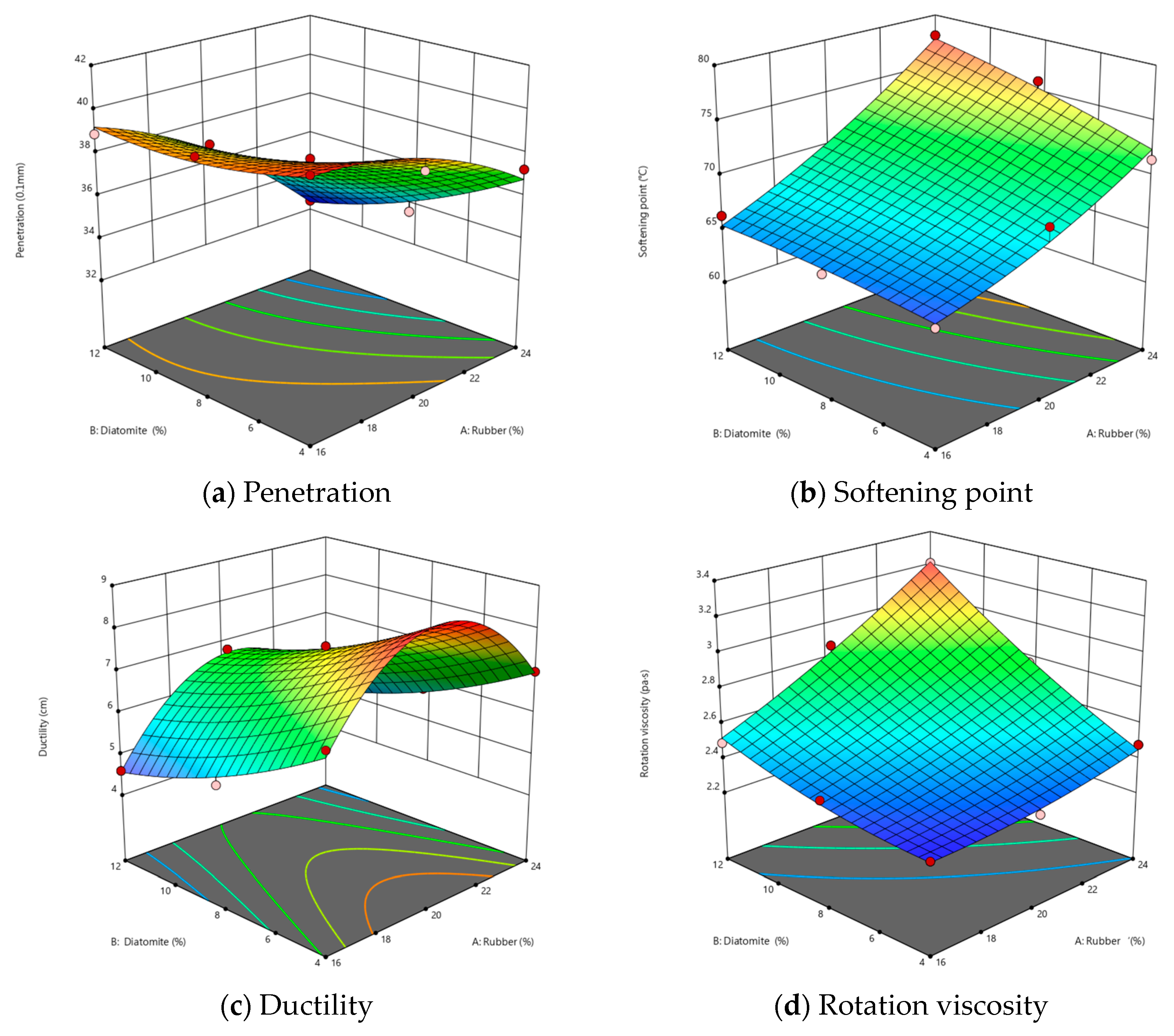

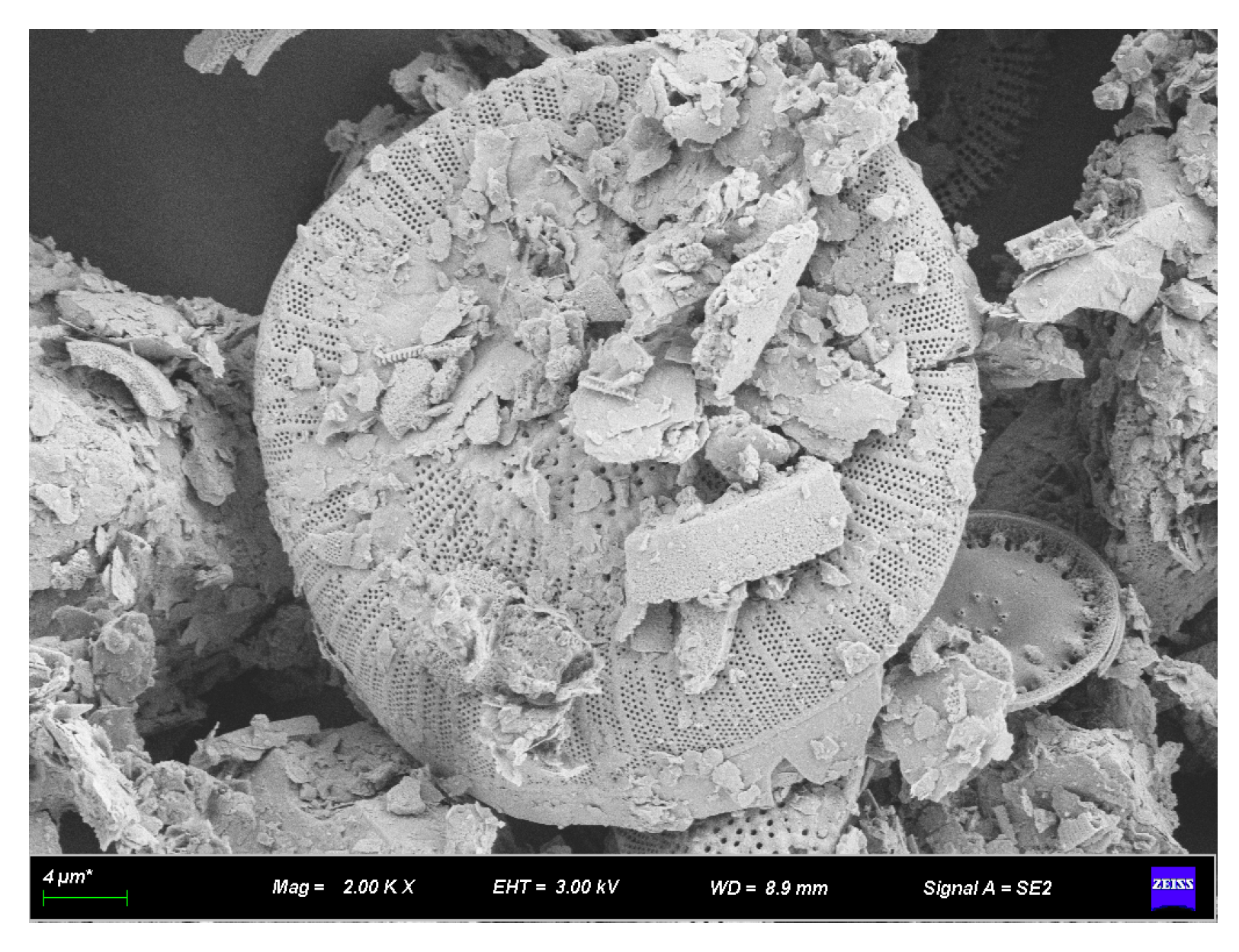
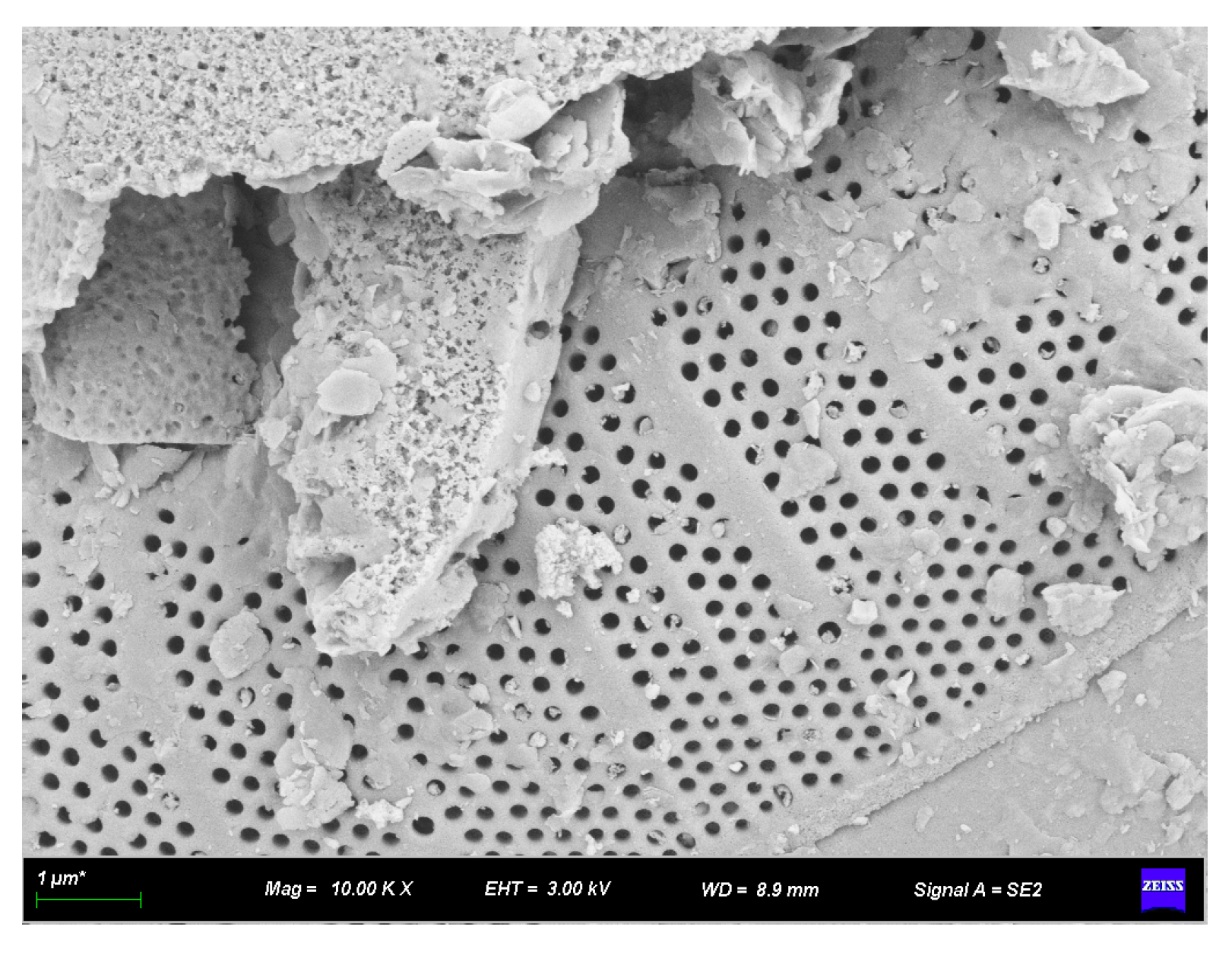

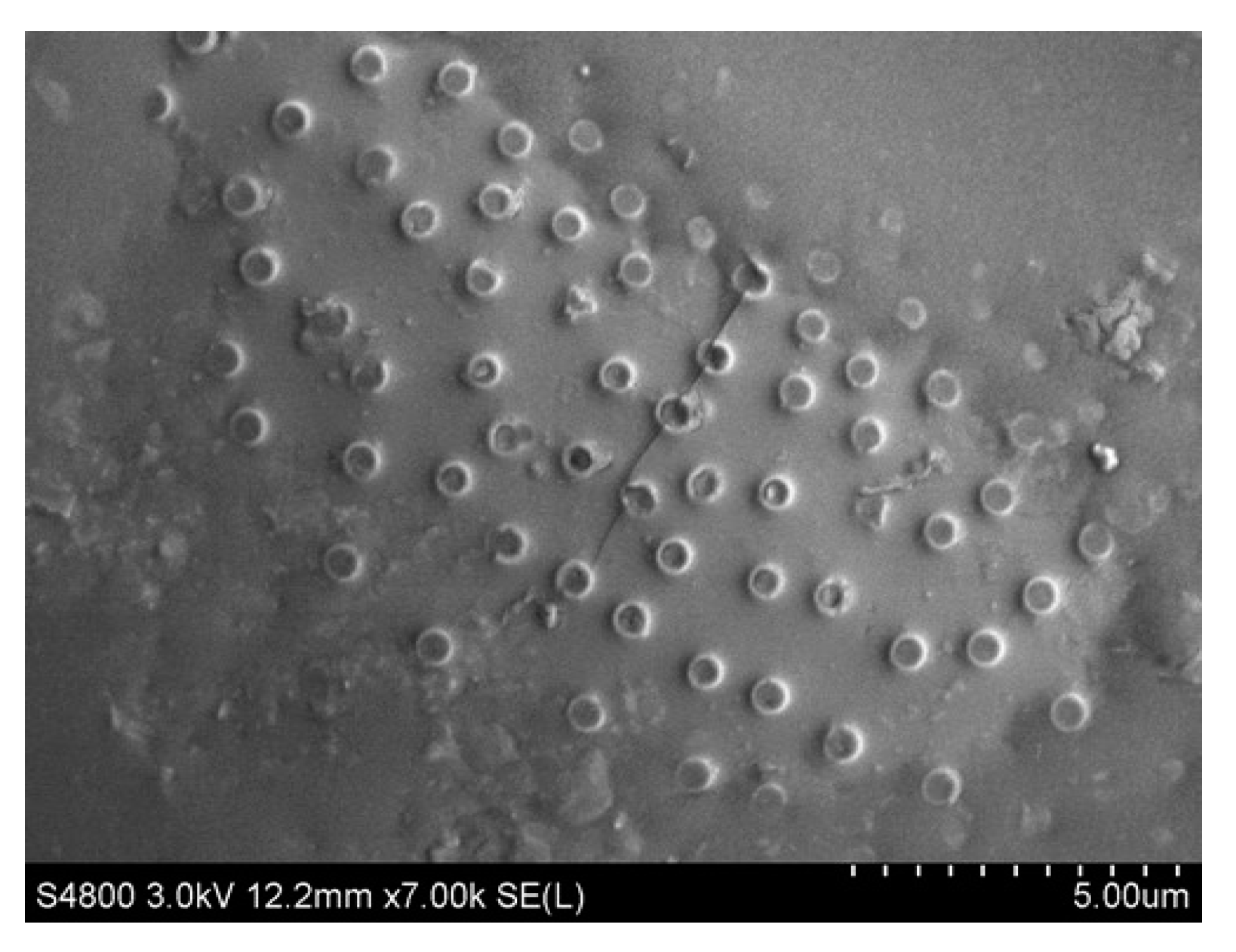
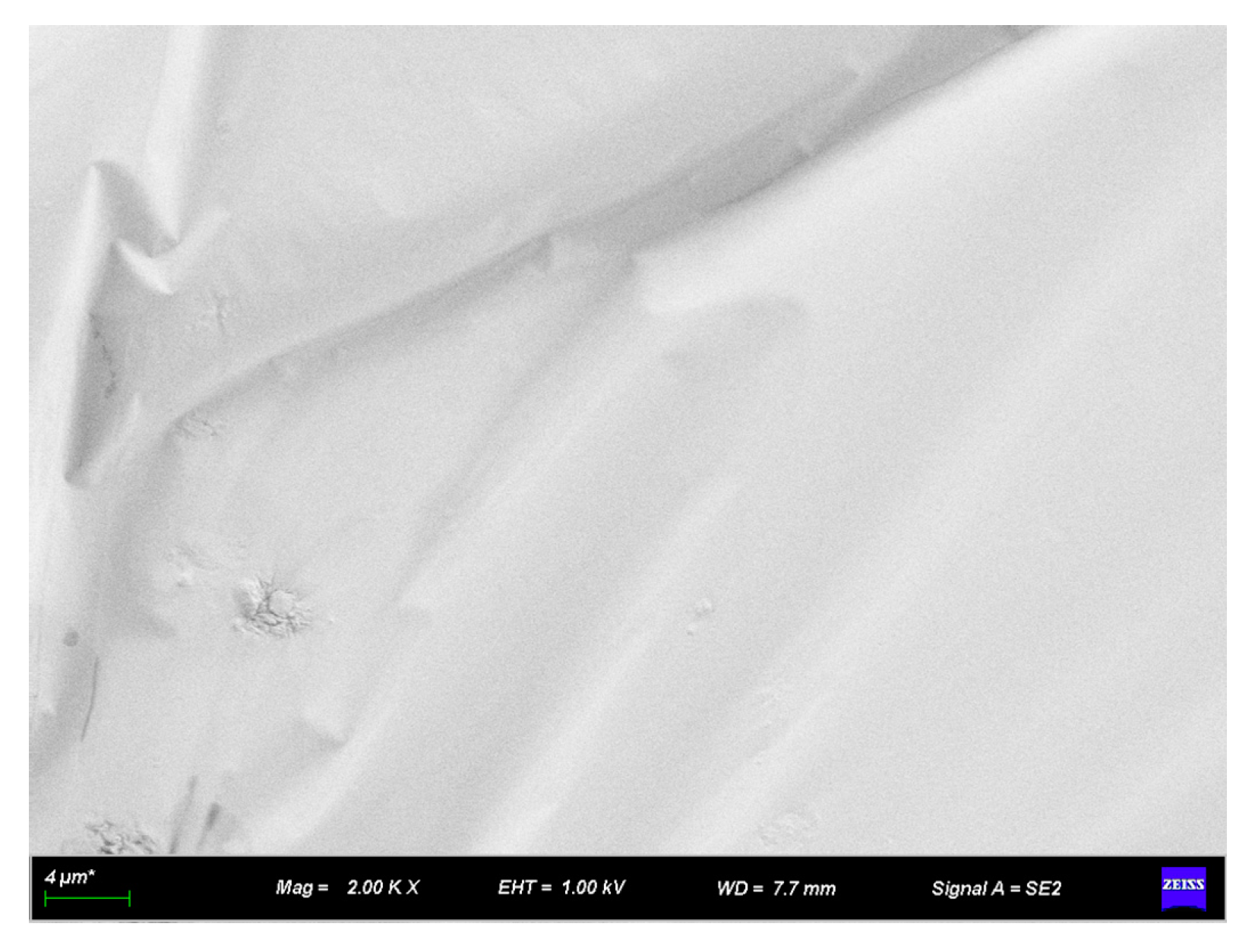
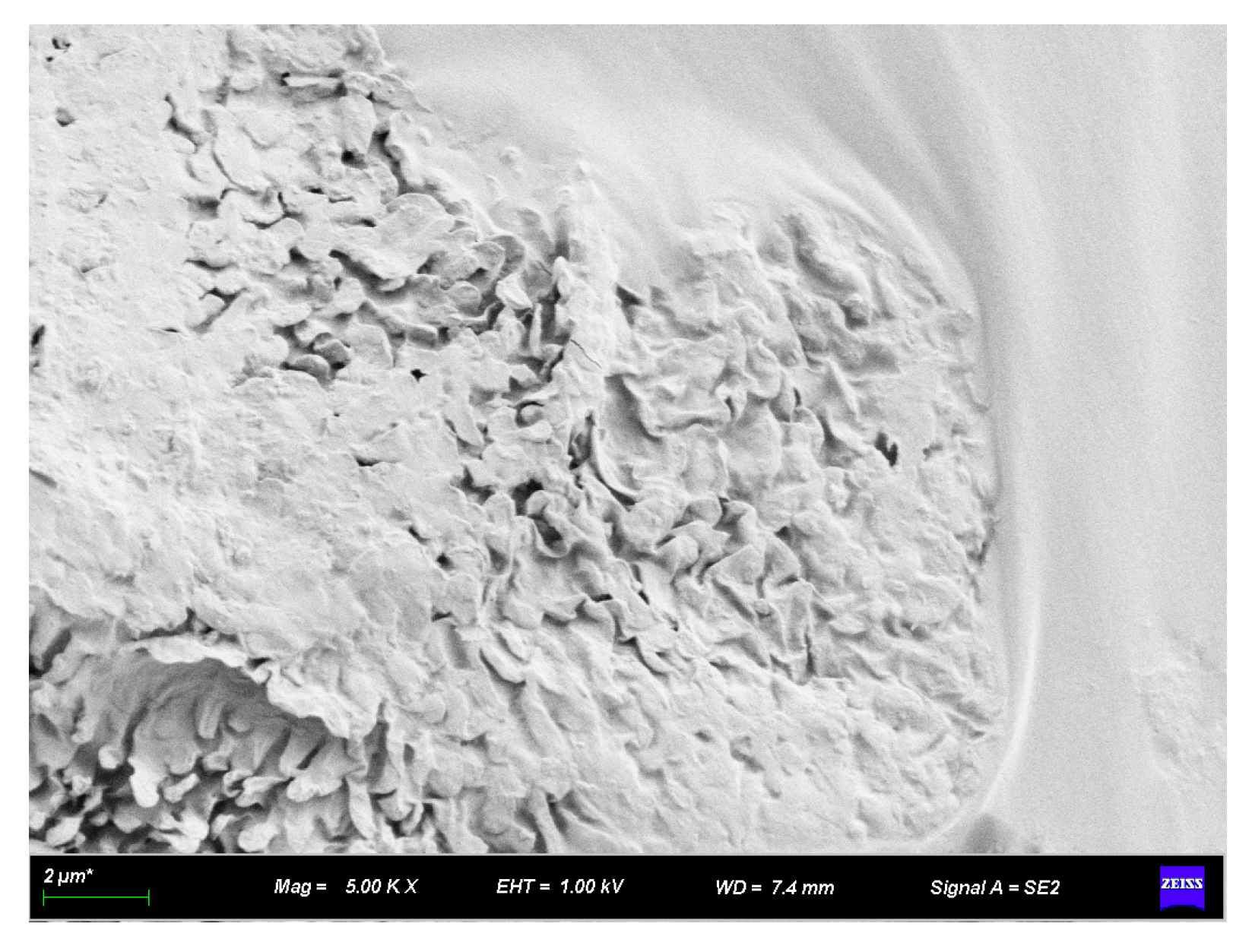




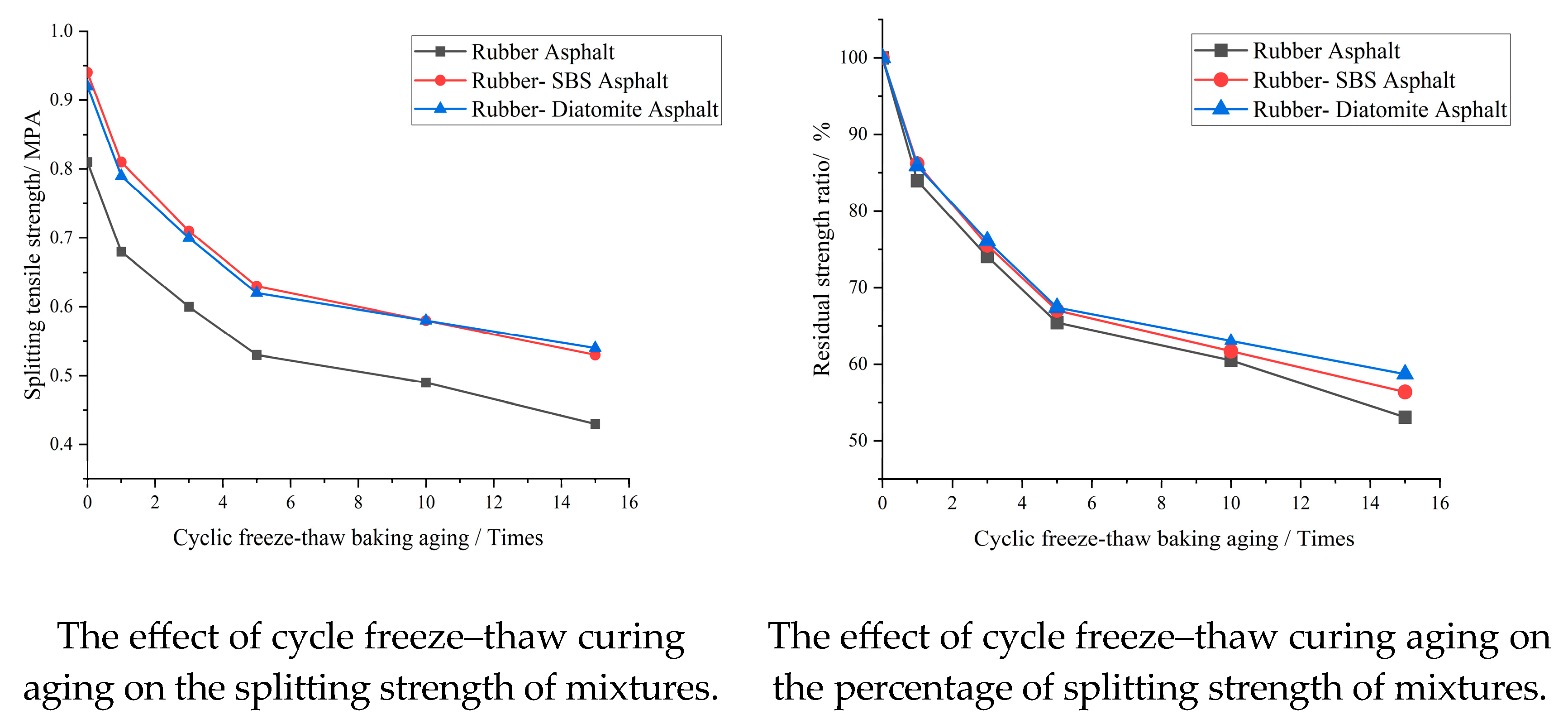
| Technical Parameter | Unit | Requirements | Test Value | |
|---|---|---|---|---|
| Penetration (25 °C, 5 s, 100 g) | mm | 60~80 | 66 | |
| Softening Point | °C | ≥46 | 47.2 | |
| 15 °C Ductility | cm | >100 | >100 | |
| After RTFOT | Mass Variation | % | ±0.8 | −0.2 |
| Residual penetration ratio | % | ≥61 | 67.5 | |
| Ductility | cm | ≥6 | 7.1 | |
| Technical Parameters | Unit | Requirements | Test Value | |
|---|---|---|---|---|
| Physical properties | Relative density | - | 1.23 | 1.23 |
| Humidity | % | 0.2 | 0.2 | |
| Metal content | % | 0.011 | 0.011 | |
| Fiber content | % | 0.078 | 0.078 | |
| Chemical properties | Ash content | % | 6.12 | 6.12 |
| Acetone extract | % | 4.03 | 4.03 | |
| Carbon black content | % | 31.244 | 31.244 | |
| Rubber hydrocarbon content | % | 55.46 | 55.46 | |
| Technical Parameters | Unit | Test Value |
|---|---|---|
| Density | g/cm3 | 2.15 |
| Average particle size | μm | 15.22 |
| Oil absorption rate | g/cm3 | 1.45 |
| Specific surface area | g/cm2 | 47.65 |
| Void volume | g/cm3 | 0.02 |
| Average radius | nm | 2.12 |
| Indexes | Test Value | Requirements | |
|---|---|---|---|
| Apparent relative density (g/cm3) | gravel (10–20 mm) | 2.73 | ≥2.60 |
| gravel (5–10 mm) | 2.68 | ||
| grit (0–5 mm) | 2.75 | ≥2.50 | |
| Crushing value (%) | 17 | ≤26.00 | |
| Los Angeles wear loss (%) | 25 | ≤28.00 | |
| Sand equivalent (%) | 75 | ≥60.00 |
| Indexes | Unit | Requirements | Test Result | Test Method | |
|---|---|---|---|---|---|
| Apparent density, not less than | t/m3 | 2.50 | 2.714 | T 0352-2000 | |
| Moisture content, not greater than | % | 1 | 0.18 | T 0103 | |
| Particle size range | <0.6 mm | % | 100 | 100.0 | T 0351-2000 |
| <0.15 mm | % | 90~100 | 94.8 | ||
| <0.075 mm | % | 75~100 | 86.7 | ||
| Serial Number | Asphalt (%) | Rubber Powder Proportion (%) | Diatomite Proportion (%) |
|---|---|---|---|
| A1 | 100 | 16 | 4 |
| A2 | 100 | 16 | 8 |
| A3 | 100 | 16 | 12 |
| A4 | 100 | 20 | 4 |
| A5 | 100 | 20 | 8 |
| A6 | 100 | 20 | 12 |
| A7 | 100 | 24 | 4 |
| A8 | 100 | 24 | 8 |
| A9 | 100 | 24 | 12 |
| Sieve Size (mm) | 16 | 13.2 | 9.5 | 4.75 | 2.36 | 1.18 | 0.6 | 0.3 | 0.15 | 0.075 |
|---|---|---|---|---|---|---|---|---|---|---|
| Upper limit | 100 | 100 | 70 | 38 | 28 | 24 | 18 | 14 | 11 | 7 |
| Lower limit | 100 | 90 | 50 | 20 | 15 | 12 | 8 | 5 | 3 | 2 |
| Synthetic grade | 100 | 99.7 | 64.3 | 31.0 | 22.7 | 16.8 | 11.6 | 8.9 | 6.9 | 5.5 |
| No. | Asphalt Type | Penetration (0.1 mm) | Softening Point (°C) | Ductility (cm) | Rotational Viscosity (Pa·s) |
|---|---|---|---|---|---|
| A1 | Rubber–Diatomite 16 + 4 | 40.2 | 63.9 | 6.9 | 2.31 |
| A2 | Rubber–Diatomite 16 + 8 | 39.4 | 64.6 | 5.2 | 2.39 |
| A3 | Rubber–Diatomite 16 + 12 | 38.89 | 66.3 | 4.6 | 2.49 |
| A4 | Rubber–Diatomite 20 + 4 | 38.78 | 68.8 | 8.6 | 2.31 |
| A5 | Rubber–Diatomite 20 + 8 | 37.77 | 69.2 | 7.6 | 2.54 |
| A6 | Rubber–Diatomite 20 + 12 | 36.93 | 69.4 | 6.8 | 2.87 |
| A7 | Rubber–Diatomite 24 + 4 | 37.27 | 71.5 | 7.0 | 2.48 |
| A8 | Rubber–Diatomite 24 + 8 | 33.57 | 76 | 5.8 | 2.77 |
| A9 | Rubber–Diatomite 24 + 12 | 32.45 | 78 | 4.9 | 3.21 |
| Test | Asphalt (%) | Rubber (%) | Diatomite (%) | Penetration (25 °C, 0.1 mm) | Softening Point (°C) | Ductility (5 °C/cm) | Rotational Viscosity (Pa·s) |
|---|---|---|---|---|---|---|---|
| Predicted value | 100 | 22 | 4 | 38.2 | 69.7 | 8.36 | 2.389 |
| Experimental value | 100 | 22 | 4 | 38.1 | 70.5 | 8.3 | 2.391 |
| Types of Asphalt | Optimum Amount of Asphalt (g/cm3) | Density (g/cm3) | VV (%) | VFA (%) | VMA (%) | MS (KN) | FL (mm) |
|---|---|---|---|---|---|---|---|
| Rubber asphalt | 5.6 | 2.57 | 4.4 | 73.8 | 16.8 | 10.60 | 3.21 |
| Rubber–SBS asphalt | 5.8 | 2.69 | 4.5 | 73.9 | 17.2 | 13.31 | 3.20 |
| Rubber–Diatomite asphalt | 6.0 | 2.70 | 4.4 | 73.7 | 17.1 | 13.44 | 3.14 |
| Types of Asphalt | Time1 (min) | Time2 (min) | D1 (mm) | D2 (mm) | Dynamic Stability (times/mm) |
|---|---|---|---|---|---|
| Rubber asphalt | 45 | 60 | 2.669 | 2.860 | 3298 |
| Rubber–SBS asphalt | 45 | 60 | 2.440 | 2.605 | 3818 |
| Rubber–diatomite asphalt | 45 | 60 | 2.381 | 2.530 | 4228 |
| Types of Asphalt | Dynamic Stability/(times-mm-1) | ||
|---|---|---|---|
| Unaging | Short-Term Aging | Long-Term Aging | |
| Rubber asphalt | 3298 | 4452 | 4979 |
| Rubber–SBS asphalt | 3818 | 4848 | 5406 |
| Rubber–diatomite asphalt | 4228 | 5158 | 5538 |
| Types of Asphalt | Number of Freeze–Thaw Cycles | Split Strength (MPA) | Residual Strength Percentage (%) |
|---|---|---|---|
| Rubber asphalt | 0 | 0.81 | 100.00 |
| 1 | 0.68 | 83.95 | |
| 3 | 0.59 | 72.84 | |
| 5 | 0.51 | 62.96 | |
| Rubber–SBS asphalt | 0 | 0.94 | 100.00 |
| 1 | 0.84 | 89.36 | |
| 3 | 0.74 | 78.70 | |
| 5 | 0.66 | 70.21 | |
| Rubber–diatomite asphalt | 0 | 0.92 | 100.00 |
| 1 | 0.8 | 86.96 | |
| 3 | 0.71 | 77.17 | |
| 5 | 0.63 | 68.48 |
| Types of Asphalt | Number of Freeze–Thaw Cycles Drying Aging | Split Strength (MPA) | Residual Strength Percentage (%) |
|---|---|---|---|
| Rubber–SBS asphalt | 0 | 0.81 | 100.00 |
| 1 | 0.68 | 83.95 | |
| 3 | 0.6 | 74.07 | |
| 5 | 0.53 | 65.43 | |
| 10 | 0.49 | 60.49 | |
| 15 | 0.43 | 53.09 | |
| Rubber–SBS asphalt | 0 | 0.94 | 100.00 |
| 1 | 0.81 | 86.17 | |
| 3 | 0.71 | 75.53 | |
| 5 | 0.63 | 67.02 | |
| 10 | 0.58 | 61.70 | |
| 15 | 0.53 | 56.38 | |
| Rubber–diatomite asphalt | 0 | 0.92 | 100.00 |
| 1 | 0.79 | 85.87 | |
| 3 | 0.70 | 76.09 | |
| 5 | 0.62 | 67.39 | |
| 10 | 0.58 | 63.04 | |
| 15 | 0.54 | 58.70 |
Disclaimer/Publisher’s Note: The statements, opinions and data contained in all publications are solely those of the individual author(s) and contributor(s) and not of MDPI and/or the editor(s). MDPI and/or the editor(s) disclaim responsibility for any injury to people or property resulting from any ideas, methods, instructions or products referred to in the content. |
© 2023 by the authors. Licensee MDPI, Basel, Switzerland. This article is an open access article distributed under the terms and conditions of the Creative Commons Attribution (CC BY) license (https://creativecommons.org/licenses/by/4.0/).
Share and Cite
Tan, B.; Su, Y.; Fan, Y.; Zhang, W.; Li, Q. Preparation and Road Performance Study of Rubber–Diatomite Composite-Modified Asphalt Mixture. Materials 2023, 16, 7359. https://doi.org/10.3390/ma16237359
Tan B, Su Y, Fan Y, Zhang W, Li Q. Preparation and Road Performance Study of Rubber–Diatomite Composite-Modified Asphalt Mixture. Materials. 2023; 16(23):7359. https://doi.org/10.3390/ma16237359
Chicago/Turabian StyleTan, Bo, Youliang Su, Yuzhu Fan, Wanzhen Zhang, and Qing Li. 2023. "Preparation and Road Performance Study of Rubber–Diatomite Composite-Modified Asphalt Mixture" Materials 16, no. 23: 7359. https://doi.org/10.3390/ma16237359





